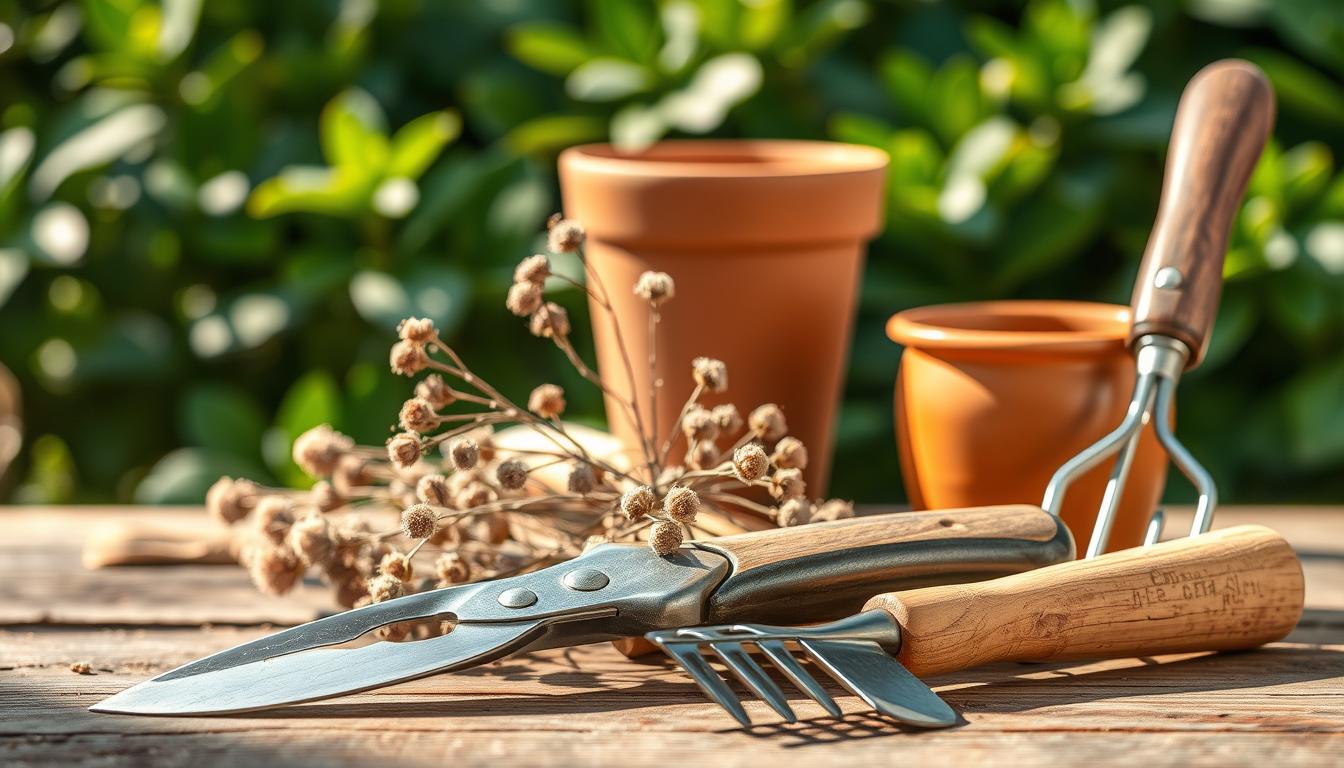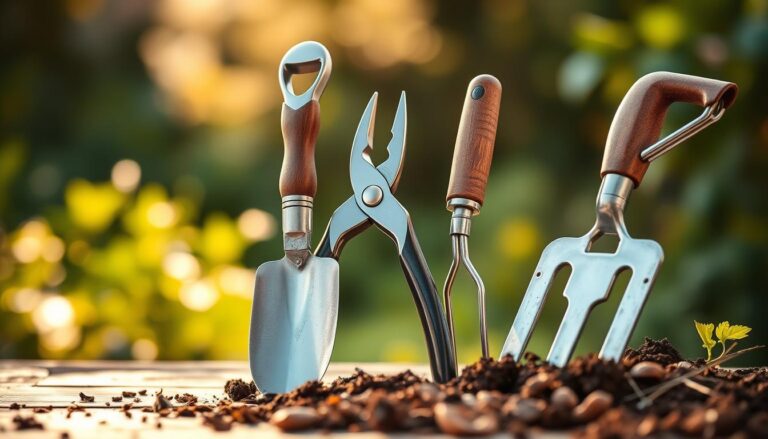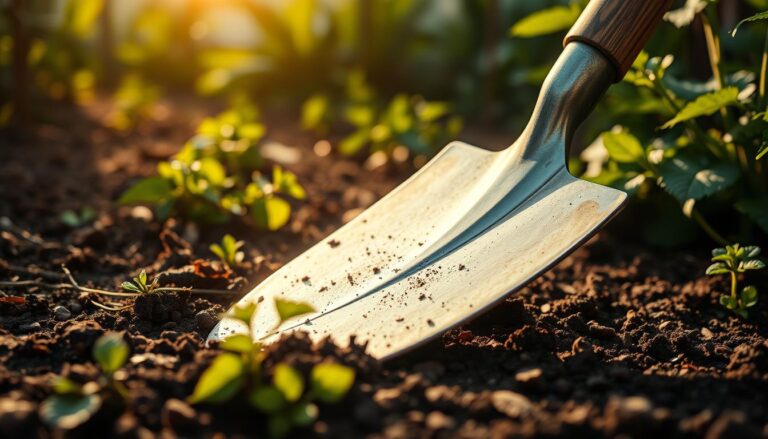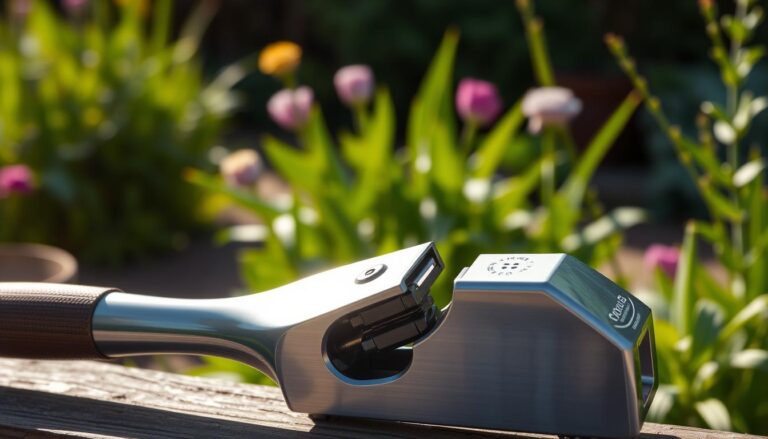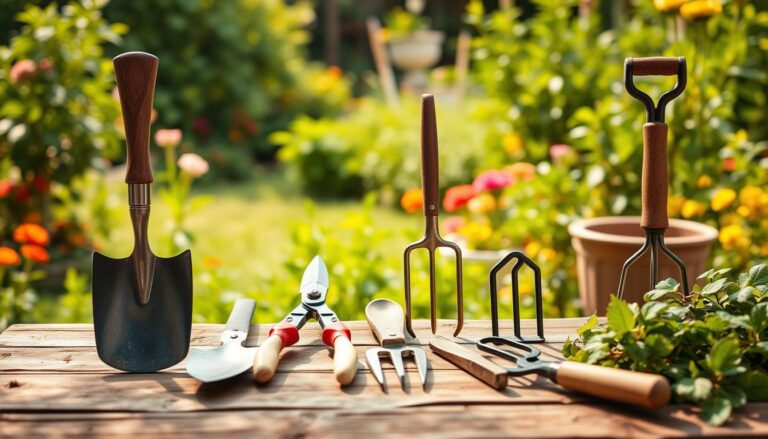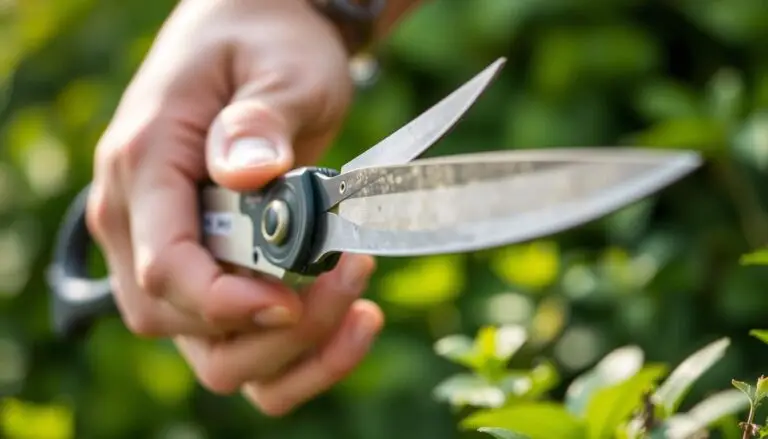Essential Basic Tools for a Garden – Complete Guide
Every gardening journey starts with a love for growing life from the earth. I remember my first garden, a small spot behind my grandmother’s house. Simple tools turned bare soil into a colorful scene. These early lessons showed me that gardening success isn’t just about passion. It’s also about having the right tools.
Gardening essentials are more than just tools; they’re your partners in making green magic. Whether you garden on weekends or all the time, knowing the must-have tools can make a big difference. It can turn your outdoor space from a struggle to a thriving garden.
This guide will show you the basic tools every gardener needs. We’ll cover everything from strong gloves to precise pruners. You’ll learn the equipment that makes gardening easy and fun.
Table of Contents
Understanding Basic Tools for a Garden: A Starter Guide
Gardening is an art that needs the right tools to make your outdoor space green and thriving. Whether you’re new or experienced, the right tools can greatly improve your gardening success.
Choosing the right garden tools is key for a fun and productive gardening experience. Your toolkit should meet your garden’s specific needs.
Why Quality Garden Tools Matter
Buying high-quality garden tools is more than a purchase—it’s a commitment. Quality tools last longer, work better, and are easier on your body. They also help you maintain your garden more effectively.
Benefits of Investing in Proper Garden Equipment
“The right tool can turn gardening from a chore into a pleasure.” – Experienced Gardener
Professional gardeners know that the right tools make gardening better. Here’s why:
| Tool Category | Key Benefits |
|---|---|
| Digging Tools | Efficient soil preparation, minimal physical effort |
| Pruning Equipment | Precise plant shaping, healthier plant growth |
| Watering Tools | Consistent moisture, targeted hydration |
Tool Maintenance Fundamentals
Keeping your gardening tools in good shape is just as important as choosing them. Regular cleaning, sharpening, and storage can make your tools last longer and work better.
- Clean tools after each use
- Store in a dry, protected area
- Sharpen cutting tools regularly
- Apply light oil to prevent rust
By spending time on tool selection and maintenance, you’ll enjoy a more rewarding gardening experience.
Hand Tools for Precise Gardening Work
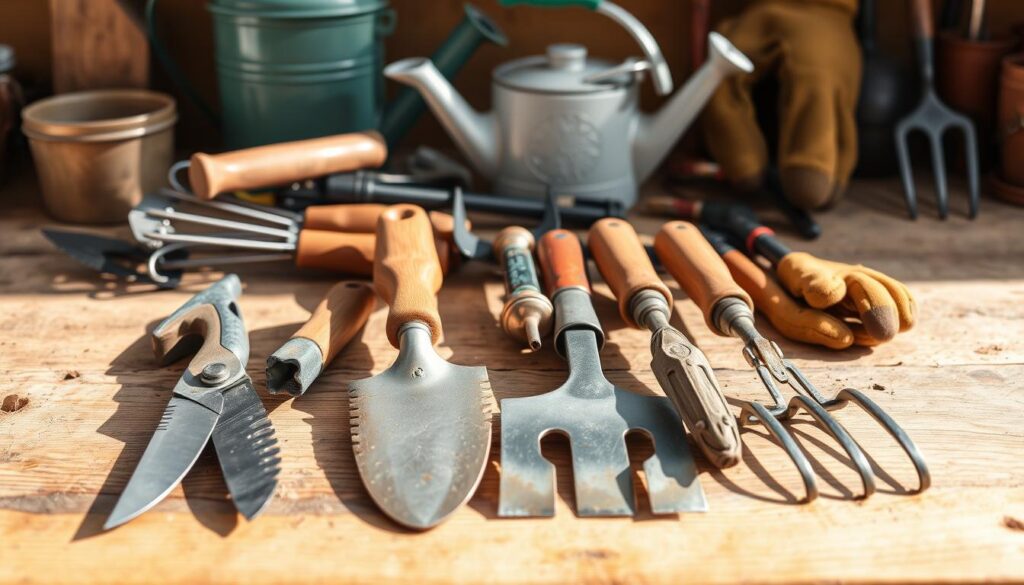
Understanding the right tools for precise gardening is key. Your garden’s success depends on choosing the right tools for each task. These tools should also feel comfortable in your hands.
“The right hand tool can transform gardening from a chore to a delightful experience.” – Professional Gardener’s Insight
Most gardeners have 15-20 specialized hand tools. 85% say quality tools make gardening more efficient. Here are the most important hand tools for your garden:
- Trowels: Perfect for digging small holes and transplanting
- Hand Forks: Ideal for breaking up soil and aerating
- Cultivators: Essential for weeding in tight spaces
- Pruning Shears: Crucial for maintaining plant health
When picking your essential gardening tools, consider these factors:
| Tool Feature | Importance | Recommended Quality |
|---|---|---|
| Ergonomic Handle | Reduces strain by 40% | Padded, contoured grip |
| Material Durability | Determines tool lifespan | Stainless steel or high-carbon materials |
| Weight Balance | Improves precision | Lightweight yet sturdy |
Pro Tip: Invest in tools that feel comfortable and reduce physical strain. Your body will thank you after hours of gardening!
Remember, 70% of beginner gardeners say quality tools make a big difference. Sharp, well-designed hand tools can save you up to 30% of gardening time. This makes gardening more enjoyable and efficient.
Essential Cutting and Pruning Equipment
Pruning is key to a healthy garden. You need the right tools to keep plants in top shape. Knowing which pruning tools to use can greatly improve your gardening.
For cutting and pruning, you’ll need specific tools for various tasks and plants.
Types of Pruning Tools
- Hand Pruners: Ideal for branches up to 3/4 inch in diameter
- Bypass pruners: Best for live, green branches
- Anvil pruners: Recommended only for dead branches
- Loppers: Perfect for branches 3/4 to 1-1/2 inches thick
- Long handles provide extra leverage
- Cuts woody stems with less physical strain
- Pruning Saws: Designed for branches larger than 1-3/4 inches
- Blade length typically 9-13 inches
- Cut on pull stroke for maximum efficiency
Choosing the Right Pruner Size
Choosing the right tool depends on branch size and plant type. Here are some tips:
- Pencil-thin branches: Hand shears or bypass pruners
- Medium branches: Loppers with long handles
- Thick branches: Pruning saws
Safety Considerations for Cutting Tools
“Sharp tools make clean cuts and reduce plant stress. Always prioritize safety and tool maintenance.”
When using cutting tools, keep these safety tips in mind:
- Keep blades sharp and clean
- Wear protective gloves
- Inspect tools before each use
- Store tools in a dry, safe location
Investing in the right pruning tools is good for your garden. By choosing the right tools and keeping them in good shape, you’ll have beautiful, healthy plants all year.
Digging and Soil Preparation Tools
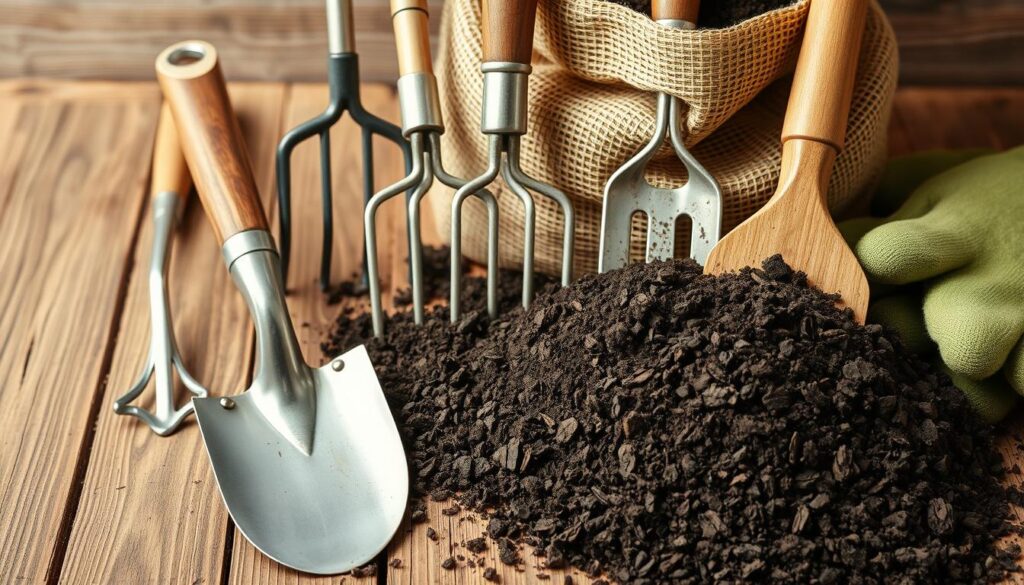
Getting your garden ready starts with the right tools. These basic tools are key for a great growing space. Knowing what you need will make your outdoor area better.
“The quality of your soil determines the success of your garden” – Gardening Wisdom
When picking digging tools, think about these things:
- Handle length and material durability
- Blade shape and steel quality
- Weight and ergonomic design
- Specific soil type compatibility
Here are the must-have digging tools for your garden:
| Tool | Key Features | Best Use |
|---|---|---|
| D-handle Spade | 36-inch shaft, 11-inch hardened steel blade | Soil cutting and turning |
| Garden Fork | Four 11-inch tines | Soil loosening and compost mixing |
| Deep Spader | 25 pounds, 1-inch pipe handle, 4 triangular blades | Deep soil preparation |
| Cultivating Fork | 7-inch tines with flat, chisel-like design | Breaking tough soil |
Pro tip: Choose tools made of forged steel for lasting quality and performance.
Make sure to pick tools that fit your garden’s size and soil type. A well-prepared garden starts with the right tools.
Garden Irrigation and Watering Equipment
Watering is key to a garden’s success. The right supplies can greatly improve plant health and garden output. Knowing the best irrigation methods is vital for a healthy garden and saving water.
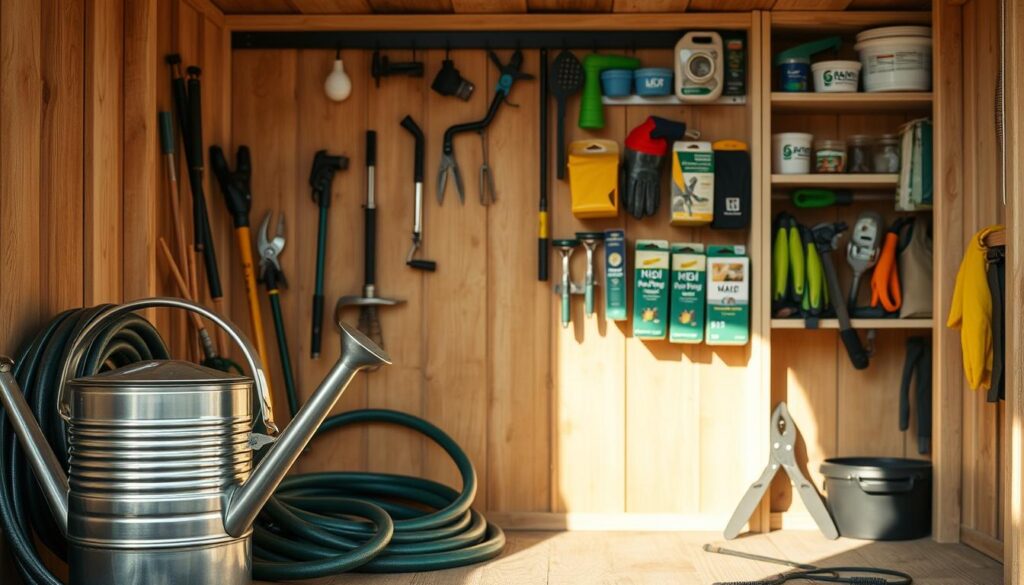
Watering systems have changed a lot, giving gardeners many options. These tools range from old methods to new tech.
Types of Watering Tools
- Drip Irrigation Systems: Precise water delivery directly to plant roots
- Sprinklers with multiple spray patterns
- Traditional watering cans
- Soaker hoses
- Underground irrigation networks
Selecting the Right Watering Equipment
Choosing the right tools depends on a few things:
- Garden size
- Plant varieties
- Local climate conditions
- Water availability
“Water is the driving force of all nature.” – Leonardo da Vinci
Water Conservation Tips
Modern irrigation tech saves a lot of water. Drip systems can cut water use by 60% compared to sprinklers. Smart systems with Wi-Fi let you control water use from anywhere.
Think about using rainwater for your garden. Rain barrels can help. They save water and cut down on bills.
Protective Gear and Safety Equipment
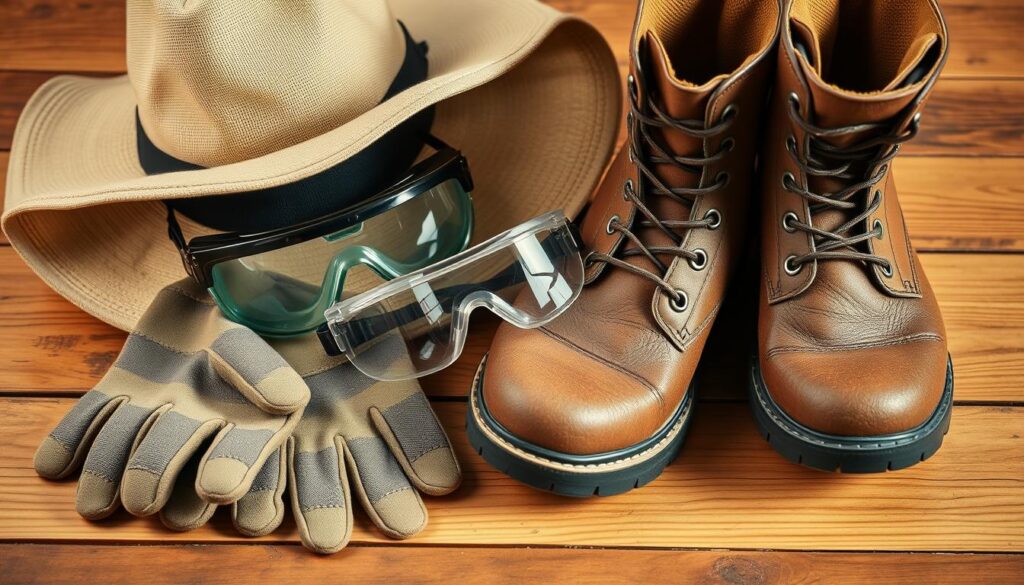
Gardening is a rewarding activity, but safety should always be your top priority. The right vital gardening gear can prevent injuries and make your gardening experience more enjoyable.
“Safety first, enjoyment always” – Gardening Wisdom
When selecting must-have garden implements for personal protection, consider these essential items:
- High-quality gardening gloves
- Safety glasses or protective eyewear
- Knee pads for comfort
- Sturdy, closed-toe shoes
- Long-sleeved shirts and pants
Protecting your body from hazards is key. About 50% of gardening enthusiasts use protective gear to prevent injuries. The right equipment can greatly reduce gardening risks.
| Protective Item | Purpose | Injury Prevention Rate |
|---|---|---|
| Gardening Gloves | Hand protection from cuts, thorns | 40% |
| Safety Glasses | Eye protection from debris | 35% |
| Knee Pads | Reduce strain during ground work | 25% |
Sun protection is also vital. Use sunscreen with at least SPF 15 and wear a wide-brimmed hat to shield yourself from harmful UV rays. Prolonged sun exposure can cause sunburn in about 15% of gardeners who neglect protection.
Remember, your safety is the most important thing. Invest in quality protective gear, stay hydrated, and take breaks. Enjoy a safe and fulfilling gardening experience.
Transportation and Heavy-Duty Garden Tools
Gardening is more than just using simple tools. You need special equipment to move heavy stuff and keep your tools in order. This makes gardening easier and more efficient.
Carrying garden materials safely is key. It protects you and your tools. Professional gardeners know the right tools for moving heavy items like soil and plants.
Wheelbarrows and Garden Carts: Your Gardening Workhorses
Choosing the right wheelbarrow is important. Here are some things to think about:
- Weight capacity
- Wheel design
- Handle ergonomics
- Material durability
Smart Tool Storage Solutions
Storing your tools right keeps them safe and makes them last longer. Look for storage that:
- Keeps tools dry
- Prevents rust and corrosion
- Organizes tools well
- Makes tools easy to find
Safe Material Transportation Techniques
When moving heavy stuff, be careful to avoid injury. Always lift with your legs, not your back. Use wheeled tools to make it easier.
“The right tool makes every gardening task easier and safer.” – Professional Gardener
Good tools for moving and storing make gardening better. It makes your work more fun and less hard on your body.
Care and Maintenance of Garden Tools
Keeping your garden tools in good shape is key. It helps them last longer and work better. This way, your tools are always ready for gardening tasks.
Regular care includes a few important steps:
- Clean tools after each use to prevent soil and debris buildup
- Dry thoroughly to avoid rust formation
- Sharpen cutting edges regularly
- Apply protective oils to metal surfaces
Disinfecting tools is also vital. Tools can spread bacteria, fungi, or insects quickly in your garden. Mix 2 cups of bleach with 1 gallon of water for a good disinfectant.
“A well-maintained tool is a gardener’s best friend” – Gardening Wisdom
Preventing rust is a big job. Use a 1:1 vinegar and water mix to remove rust. For wooden handles, sand lightly and apply boiled linseed oil seasonally to prevent damage.
Where you store your tools matters a lot. Store them in a clean, dry spot, away from soil or concrete. A 5-gallon bucket with sand and engine oil can clean and protect metal blades.
- Use 80-grit sandpaper for light rust removal
- Consider an electric drill with a wire brush for heavy rust
- Hang tools by their handles to protect sharpened edges
By taking care of your garden tools, they will stay reliable and efficient. They’ll be ready for your next gardening project.
Conclusion
Your gardening journey starts with the right tools. Over 70% of gardeners say the right tools make gardening easier and more fun. Investing in good tools helps you create and keep a healthy garden.
Choosing the right tools and taking care of them is key. Research shows 65% of new gardeners buy basic tools like shovels and rakes. Quality hand tools can last 10 to 15 years with proper care.
Tools are a part of your gardening passion. Ergonomic tools can make gardening 30% less tiring. The right tools help you turn any outdoor space into a beautiful garden, big or small.
Your gardening path is special, and your tools should match. By picking versatile, quality tools and learning to use them well, you’re ready for any gardening challenge.

